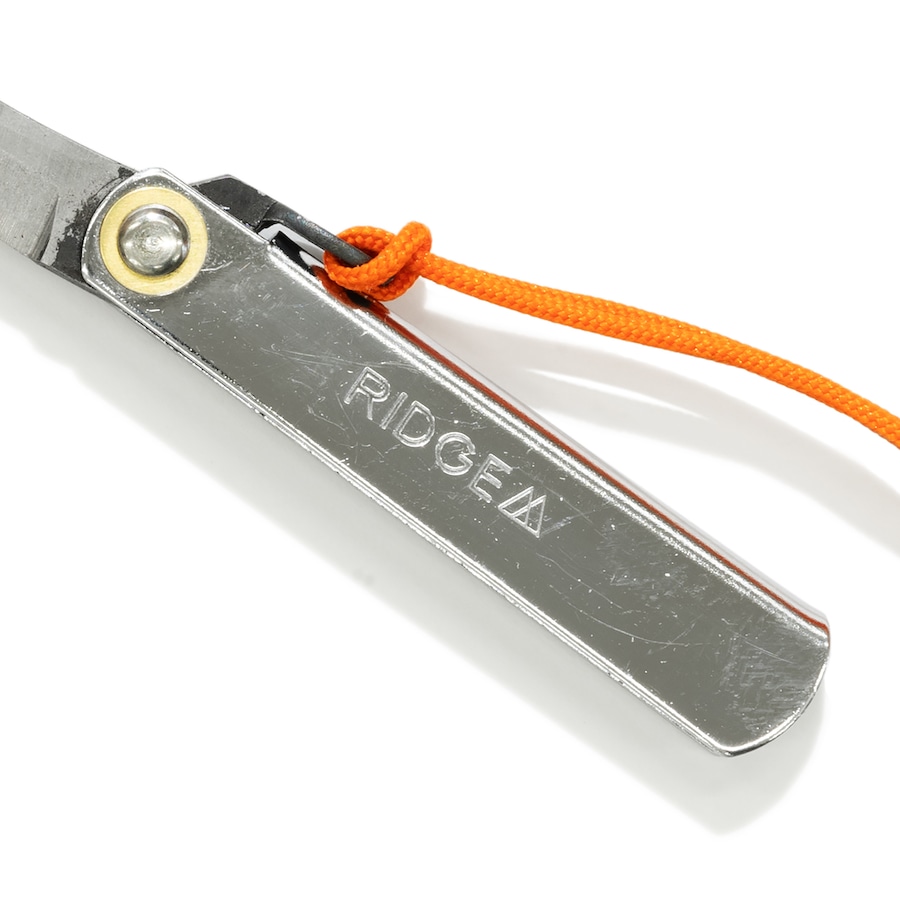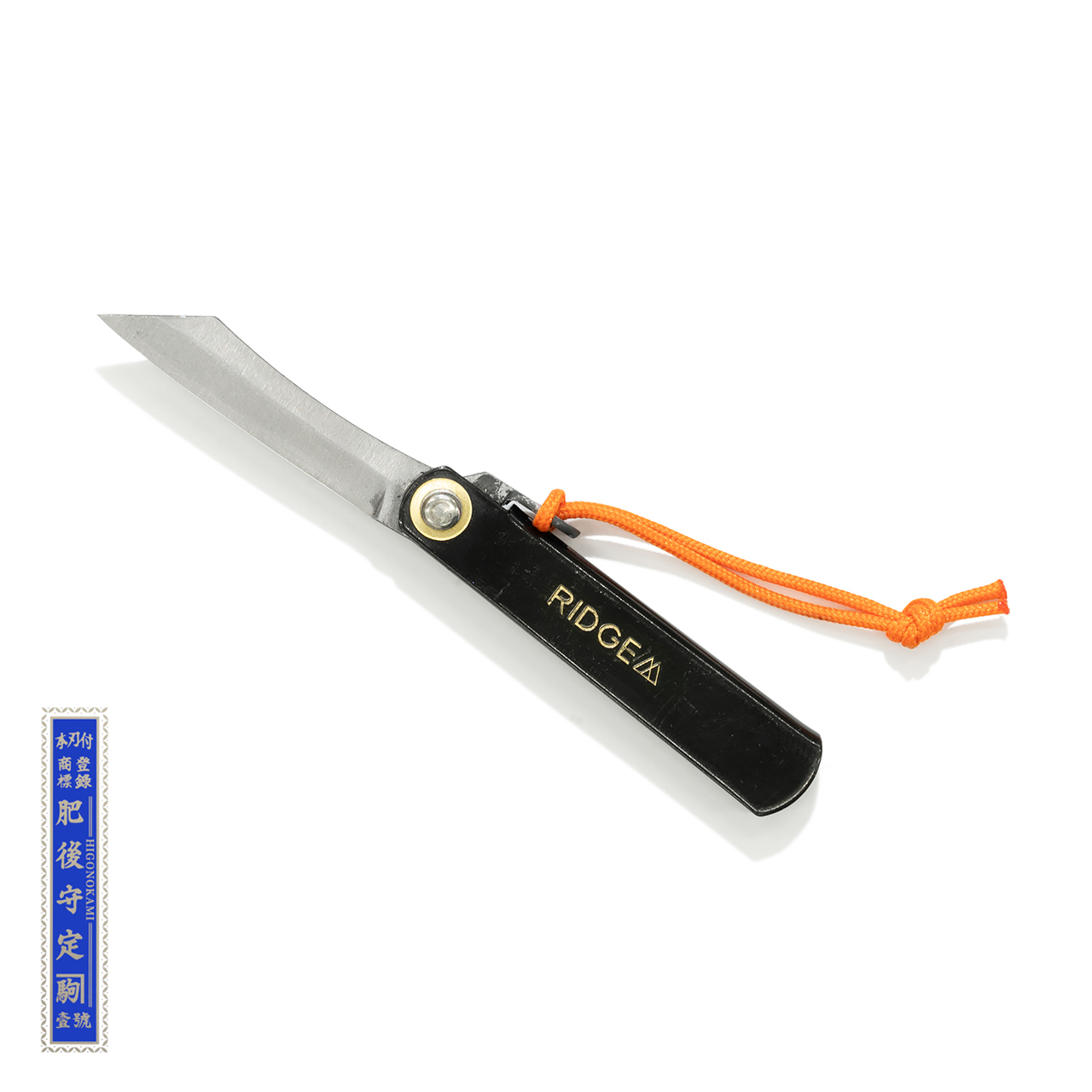Higonokami Micro Knife
Introduction

I have used many different types of folding knives in the past, including "OPINEL", "LEATHERMAN", "VICTORINOX", "The James Brand", and many more... all of which were made overseas.
I wondered if there were any folding knives made in Japan, and then I learned about a knife called "Higonokami." The "Higonokami" is a knife with a unique Japanese tradition and history, and I was fascinated by its simple yet functional beauty.
When I first started mountaineering, I often enjoyed cooking full-scale meals using fresh ingredients in the mountains, and I needed a fairly large knife. However, these days I rarely cook full-scale meals while hiking. I often use freeze-dried foods, or enjoy the food provided at mountain huts, if there are any.
Therefore, the knife I carry around doesn't need to be large. I rarely need to use a knife, but I think this size is enough. It's also a knife that's easy to carry around as a talisman.
The origins and present of Higo no Kami
It is said that the knife was based on a knife* that hardware wholesaler Shigematsu Taisaburo brought back from Kagoshima around 1894, and the designer devised a structure that allowed the blade and handle to be folded up and added a "chikiri" (tail) to make it easier to carry.
At that time, many of our clients were in southern Kyushu (mainly Kumamoto), so we sold the product under the name "Higonokami Knife," which was well received locally and led to a significant increase in sales.
It is generally accepted that the blade has always been double-edged (V-shaped cross-section) (this is different from the single-edged cutting).
The shape of the blade has also changed little by little. At first, the blade had a sharp point (bamboo blade), but now it is square. The handles also came in vertical and horizontal curves. (Currently, vertical curves are not manufactured as standard products.)
It is said that the fame of Higonokami knives spread even further when the future Emperor Taisho took such a liking to a Higonokami on display at the First Kobe Trade and Production Exhibition held in Kobe City in 1911 that he purchased it.
The Higonokami Knife Association was established in 1899, and at its peak it had become a large industry with 40 registered manufacturers and 200 people engaged in the production of Higonokami knives.
However, many inferior imitations of Higonokami began to be produced in various places, causing various problems, so in 1910 the name "Higonokami" was registered as a trademark, and from then on "Higonokami" could only be used by members of the Miki Western Sword Manufacturers Association.
Later, with the advent of cutters and electric pencil sharpeners, and in the 1950s a movement to ban knives arose, which dealt a major blow to production and sales.
There has been a constant stream of businesses changing jobs or going out of business, and currently, Nagao Kanekoma Seisakusho is the only one that is allowed to use the "Higonokami" trademark.
Spec
Material: Blade: SK steel, Sheath: Brass (plated)
Size: Blade approx. 40mm x sheath approx. 55mm x thickness 23mm
Weight: Approx. 15g
Country of origin: Japan Producer: Kanekoma Seisakusho Co., Ltd., Miki City, Hyogo Prefecture
The SK steel used in the blade is widely used in the manufacture of knives, tools, dies, etc. Due to its hardness and durability, it is also used in cutting tools and dies, as well as some gardening tools and kitchen utensils. In addition, proper heat treatment can be used to maximize its performance.
However, tools and equipment made from SK steel have the disadvantage of being prone to rust, so they must be properly maintained after use and stored with care.
Higonokami Part Name

How to extend the blade

When extending the blade from the folded position, press down on the sheath while pushing up on the blade tip.
When doing so, be careful not to get injured by the blade.

The scabbard is stamped with "RIDGE" and "Higonokami".

In the image above, the cutting tip, back and cut edge are processed in their natural state using the steel.
Therefore, when you first start using the product, the orange cord that is threaded through your hand and the tip may become stained with the black color of the steel, but this is a characteristic of the product. Thank you for your understanding.
Individual differences and small scratches due to handmade nature

Unlike industrial products, Higonokami are still assembled by craftsmen one by one by hand. Therefore, there are inevitably slight individual differences due to the manufacturing process. Some products may have small scratches as shown in the image above. Thank you for your understanding.
Adjustment if the fold becomes loose

The folding may become loose with use. If this occurs, please adjust it yourself.
Place it on an anvil or other object that has a certain degree of strength and lightly tap the "rivet" circled in red in the image above with a hammer or mallet to adjust the tightness.
Color
This product is available in two colors: Black and Silver.

Black

Silver
*The sheath is plated. Please note that the plating may peel off during use.
Package
It will be delivered in a special small box.

Size Chart

Collaborator
Collaborateur introduces you to the people who produce these products.

Miki City, where Kanekoma Seisakusho Co., Ltd. is located, is known as the "town of metalworking."
Miki City's history as a "town of metalwork" dates back to Toyotomi Hideyoshi's siege of Miki Castle. The battle left the town in ruins, and Hideyoshi called back the people who had been scattered across the country, working to rebuild the town. During this process, carpenters and blacksmiths gathered in the town, and the town became more lively.

Later, when carpenters' work was completed, they went to Kyoto or Osaka to work, but the quality of the tools they brought with them from Miki became famous, and Miki established itself as a "village of blacksmiths." Even today, many excellent metal tools continue to be developed and produced based on traditional techniques, and five items, including saws, chisels, planes, trowels, and knives, have been designated as traditional crafts by the country.


Mitsuo Nagao, the fifth generation owner, says that when he took over the business about 14 years ago, he actually didn't want to take it over. The reason for this was that at the time, "Higonokami" knives were hardly selling at all.


However, local government offices and others said they wanted to keep it going because it had a name for them, so they had no choice but to continue. For the first two or three years, the product received little attention, and low-priced items became mainstream at home improvement stores, so there was almost no profit. After paying the wages of the craftsmen who worked there, there was almost no money left.


The turning point came when the brand attracted the attention of customers overseas. In particular, a famous adventurer purchased a "Higonokami" knife, which was featured in a Western knife magazine, and orders from overseas increased dramatically.


Since then, orders have been steadily increasing, and we are currently on backorder. In fact, we had to wait about six months for the latest "Higonokami Micro knife."


When we first started, there were about 40 factories in the area that manufactured "Higonokami," but now there is only one left. Our goal going forward is to have more young people know about and use "Higonokami."

I am the fifth generation since the first generation Komataro started making knives in 1894. Over the course of five generations, we have survived the various periods of Higonokami for over 100 years.
This may be an old-fashioned knife that is unfamiliar to the younger generation, but we would be happy if you would use the Higonokami as the starting point of creativity, "using tools to make things."
We will continue to preserve our traditions while striving to develop new products.
This website introduces the history of Higonokami and the products that remain at Nagao Kanekoma Seisakusho. We also post information on new products, exhibitions, etc. from time to time.
Fifth Generation Mitsuo Nagao
Kanekoma Manufacturing Co., Ltd. Miki City, Hyogo Prefecture 〒673-0405
311 Hirata, Miki City, Hyogo Prefecture
https://www.higonokami.jp/index.html
Attention
- The blade has a sharp, pointed edge, so please be careful when handling it.
-This is a folding knife, so please be careful when opening and closing it.
Please be careful not to forcefully cut hard objects as this may cause the blade to chip.
・When working, be mindful of people around you.
・Please store the product in a place out of reach of small children.
- Never use for any purpose other than its intended use.
After use, wipe off any dirt and wipe with a cloth soaked in camellia oil or anti-rust oil, then store in a dry place.
















